JVC LT-32X667, LT-32X787, LT-32X887, LT-37X787, LT-37X887 User Guide
...
LCD Flat Television Users Guide
For Models:
LT-32X667
LT-32X787
LT-32X887
LT-37X787
LT-37X887
LT-37XM57
LT-40X667
LT-40X787
LT-40X887
Illustration of LT-32X787 and RM-C18G
Important Note:
In the spaces below, enter the model and serial number of your television (located at the rear of the television cabinet). Staple your sales receipt or invoice to the inside cover of this guide. Keep this user’s guide in a convenient place for future reference. Keep the carton and original packaging for future use.
Model Number:
Serial Number:
LCT2104-001B-A 0406TNH-II-IM
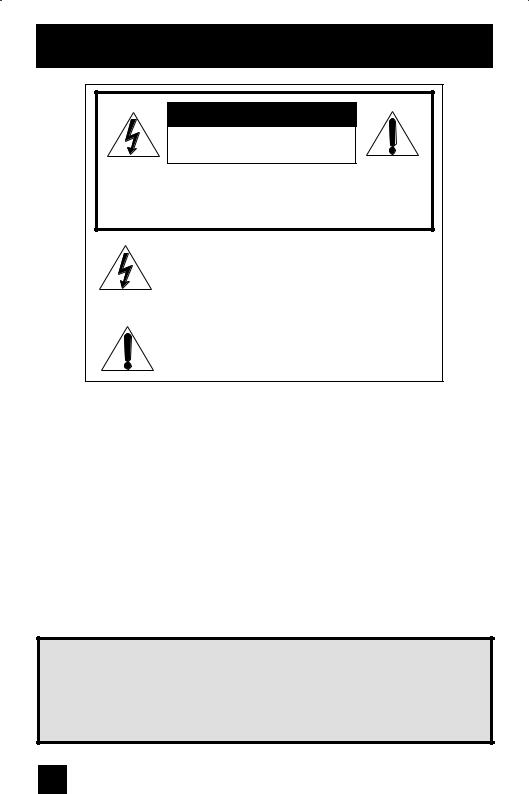
Important Safety Precautions
CAUTION
RISK OF ELECTRIC SHOCK
DO NOT OPEN
CAUTION: To reduce the risk of electric shock. Do not remove cover (or back). No user serviceable parts inside. Refer servicing to qualified service personnel.
The lightning flash with arrowhead symbol, within an equilateral triangle is intended to alert the user to the presence of uninsulated “dangerous voltage” within the product’s enclosure that may be of sufficient magnitude to constitute a risk of electric shock to persons.
The exclamation point within an equilateral triangle is intended to alert the user to the presence of important operating and maintenance (servicing) instructions in the literature accompanying the appliance.
WARNING: TO PREVENT FIRE OR SHOCK HAZARDS, DO NOT EXPOSE THIS APPARATUS TO RAIN OR MOISTURE.
CAUTION: TO INSURE PERSONAL SAFETY, OBSERVE THE FOLLOWING RULES
REGARDING THE USE OF THIS UNIT.
1. Operate only from the power source specified on the unit.
2.Avoid damaging the AC plug and power cord.
3.Avoid Improper installation and never position the unit where good ventilation is unattainable.
4.Do not allow objects or liquid into the cabinet openings.
5.In the event of trouble, unplug the unit and call a service technician. Do not attempt to repair it yourself or remove the rear cover.
Changes or modifications not approved by JVC could void the warranty.
*When you don’t use this TV set for a long period of time, be sure to disconnect both the power plug from the AC outlet and antenna for your safety.
*To prevent electric shock do not use this polarized plug with an extension cord, receptacle or other outlet unless the blades can be fully inserted to prevent blade exposure.
IMPORTANT RECYCLING INFORMATION
This product has a fluorescent lamp that contains a small amount of mercury. It also contains lead in some components. Disposal of the materials may be regulated in your community due to environmental considerations. For disposal or recycling information, please contact your local authorities, or the Electronic Industries Alliance:
http://www.eiae.org
2

•As an “ENERGY STAR®” partner,
JVC has determined that this product or product model meets the
“ENERGY STAR®” guidelines for energy efficiency.
IMPORTANT SAFETY INSTRUCTIONS
1)Read these instructions.
2)Keep these instructions.
3)Heed all warnings.
4)Follow all instructions.
5)Do not use this apparatus near water.
6)Clean only with dry cloth.
7)Do not block any ventilation openings. Install in accordance with the manufacturer's instructions.
8)Do not install near any heat sources such as radiators, heat registers, stoves, or other apparatus (including amplifiers) that produce heat.
9)Do not defeat the safety purpose of the polarized or grounding-type plug. A polarized plug has two blades with one wider than the other. A grounding type plug has two blades and a third grounding prong. The wide blade or the third prong are provided for your safety. If the provided plug does not fit into your outlet, consult an electrician for replacement of the obsolete outlet.
10)Protect the power cord from being walked on or pinched particularly at plugs, convenience receptacles, and the point where they exit from the apparatus.
11)Only use attachments/accessories specified by the manufacturer.
12)Use only with a cart, stand, tripod, bracket, or table specified by the manufacturer, or sold with the apparatus. When a cart is used, use caution when moving the cart/apparatus combination to avoid injury from tip-over.
3

13)Unplug this apparatus during lightning storms or when unused for long periods of time.
14)Refer all servicing to qualified service personnel. Servicing is required when the apparatus has been damaged in any way, such as power-supply cord or plug is damaged, liquid has been spilled or objects have fallen into the apparatus, the apparatus has been exposed to rain or moisture, does not operate normally, or has been dropped.
15)Apparatus shall not be exposed to dripping or splashing and no objects filled with liquids, such as vases, shall be placed on the apparatus.
16)Avoid improper installation and never position the unit where good ventilation is impossible. When installing this TV, distance recommendations must be maintained between the set and the wall, as well as inside a tightly enclosed area or piece of furniture. Keep to the minimum distance guidelines shown for safe operation.
|
|
200 mm |
|
|
200 mm |
150 mm |
|
150 mm |
|
||
|
|
|
|
|
|
50 mm
17)Cautions for installation
—Do not tilt the TV towards the left or right, or towards the back.
—Install the TV in a corner on the floor so as to keep cords out of the way.
—The TV will generate a slight amount of heat during operation. Ensure that sufficient space is available around the TV to allow satisfactory cooling.
18)Make enough room for inserting and removing the power plug. Place the TV as close to the outlet as possible. The main power supply for this TV is controlled by inserting or removing the power plug.
FCC Notice:
Note: This equipment has been tested and found to comply with the limits for a Class B digital device, pursuant to Part 15 of the FCC Rules. These limits are designed to provide reasonable protection against harmful interference in a residential installation. This equipment generates, uses and can radiate radio frequency energy and, if not installed and used in accordance with the instructions, may cause harmful interference to radio communications. However, there is no guarantee that interference will not occur in a
particular installation. If this equipment does cause harmful interference to radio or television reception, which can be determined by turning the equipment off and on, the user is encouraged to try to correct the interference by one or more of the following measures:
–Reorient or relocate the receiving antenna.
–Increase the separation between the equipment and receiver.
–Connect the equipment into an outlet on a circuit different from that to which the receiver is connected.
–Consult the dealer or an experienced radio/TV technician for help.
4

Warnings
We have an important note for customers who subscribe to basic cable services (do not have a separate cable box) and plan to use their JVC TV remote control to select channels.
Once you run the Auto Tuner Setup (which detects and programs all the channels your TV is receiving through the RF input), every channel number available from your cable company will appear in your television’s Channel Summary and they will all be marked as available for scanning. Even though every channel is detected and appears as available, you will only be able to view those that you specifically subscribe to from your cable company. This will likely mean there are blank channels between those channels you wish to scan or “surf”.
We apologize for any inconvenience this may cause but it is important to note that this is not a malfunction of your television. If you want to sequentially scan those channels you subscribe to without blank ones in between, you can contact your cable company for their cable box and remote.
Avoiding Ghost Images
Displaying fixed images for extended periods of time can leave a subtle but temporary ghost image on your screen. To avoid this, mix your viewing pattern.
Examples include, but are not limited to the following:
• |
Stock-market report bars |
For example... |
|
|
TV on |
TV off |
|||
• |
Shopping channel logos and pricing |
|||
|
|
|||
|
displays |
|
|
|
• |
Video game patterns or scoreboards |
|
|
|
• |
Bright station logos |
|
|
|
• |
Internet web sites or other computer-style |
|
|
|
|
images. |
|
|
|
• |
DVD discs, video tapes, laser discs |
|
|
|
• |
Broadcast, cable, satellite channels or |
XYZ |
XYZ |
|
|
digital television tuners/converters. |
|||
|
|
|
5

Warnings (Continued...)
Caring for the Cabinet
Normally, light dusting with a soft, non-scratching duster will keep your TV clean.
If you wish to wipe down the television, first unplug it. Then wipe gently with a soft cloth, slightly moistened with water. You can add a few drops of mild liquid detergent to the water to help remove spots of oily dirt.
•DO NOT allow liquid to enter the TV through the ventilation slots.
•DO NOT use strong or abrasive cleaners on the TV.
•DO NOT spray liquids or cleaners directly on the TV’s surface.
•DO NOT rub or scrub the TV harshly. Wipe the set gently with a soft cloth.
Caring for the Screen
The screen is treated with an electrostatic-proof coating. When it gets dirty, wipe it gently with a soft cloth. If the screen is very dirty, wipe it down with a cloth dipped in a diluted kitchen cleaner and thoroughly wrung-out. Then wipe immediately after with a clean, dry cloth.
Do not apply alcohol, organic solvents (like acetone), acidic or alkaline cleansers to the screen.
These will remove the coating layer and cause discolorations.
Do not push or hit the screen. This could cause scratches on the screen surface and image distortions.
6

Important Safety Precautions . . 2 Warnings . . . . . . . . . . . . . . . 5 Quick Setup . . . . . . . . . . . . . . 8
Unpacking your TV . . . . . . . . . . . . 8
Using the stand . . . . . . . . . . . . . . . 8
TV Models . . . . . . . . . . . . . . . . 9 TV Remote Control . . . . . . . . . . . 10 Getting Started . . . . . . . . . . . . . 11
The Remote Control . . . . . . . . . . 11
Connecting Your Devices . . . . . . . 12 Interactive Plug In Menu . . . . . . . . 24
Programming your remote . . . . . . . 27
Onscreen Menus . . . . . . . . . 31
Using the Guide . . . . . . . . . . . . . 31 Onscreen Menu System . . . . . . . . . 32 Initial Setup . . . . . . . . . . . . . 34 Auto Tuner Setup . . . . . . . . . . . . 34 Channel Summary . . . . . . . . . . . . 35 Channel Label . . . . . . . . . . . . . 36
V-Chip . . . . . . . . . . . . . . . . . . 37
Set Lock Code . . . . . . . . . . . . . 43 Language . . . . . . . . . . . . . . . . 44 Closed Caption . . . . . . . . . . . . . 45 Auto Shut Off . . . . . . . . . . . . . . 47 XDS ID . . . . . . . . . . . . . . . . . 47 Noise Muting . . . . . . . . . . . . . . 48 Front Panel Lock . . . . . . . . . . . . 48 V1 Smart Input . . . . . . . . . . . . 49 Video Input Label . . . . . . . . . . 50
Position Adjustment . . . . . . . . . . . 51
Power Indicator . . . . . . . . . . . . . 51 Digital-In . . . . . . . . . . . . . . . 52 Digital-In1 Audio . . . . . . . . . . . 52 Digital Setup . . . . . . . . . . . . . 53 Picture Adjust . . . . . . . . . . . . . 55 Picture Settings . . . . . . . . . . . . . 55 Color Temperature . . . . . . . . . . . . 55
Color Management . . . . . . . . . . . . 56
Dynamic Gamma . . . . . . . . . . . . . 56
Smart Picture . . . . . . . . . . . . . . . 56
Digital VNR . . . . . . . . . . . . . . . . 57 MPEG NR . . . . . . . . . . . . . . . 57 Smart Sensor . . . . . . . . . . . . . . . 57 Sensor Effect . . . . . . . . . . . . . . . 58
Reset . . . . . . . . . . . . . . . . . . 58 Sound Adjust . . . . . . . . . . . . . 59 Sound Settings . . . . . . . . . . . . . 59
Turn On Volume . . . . . . . . . . . . . 59 Volume Limit . . . . . . . . . . . . . . 59 Reset . . . . . . . . . . . . . . . . . . 59 Clock/Timers . . . . . . . . . . . . . . . . 60 Set Clock . . . . . . . . . . . . . . . . 60 On/Off Timer . . . . . . . . . . . . . . . 61
Table of Contents
Button Functions . . . . . . . . . . 62
Multi Screen Function . . . . . . . . . . |
62 |
Split . . . . . . . . . . . . . . . . . . |
62 |
Index . . . . . . . . . . . . . . . . . |
63 |
Freeze . . . . . . . . . . . . . . . . . . |
63 |
Swap . . . . . . . . . . . . . . . . . |
63 |
Select . . . . . . . . . . . . . . . . . . |
63 |
Menu . . . . . . . . . . . . . . . . . . |
63 |
OK . . . . . . . . . . . . . . . . . . . |
63 |
Back . . . . . . . . . . . . . . . . . . . |
63 |
Power . . . . . . . . . . . . . . . . . . |
64 |
Number Buttons . . . . . . . . . . . . . |
64 |
Tune . . . . . . . . . . . . . . . 64 |
|
Input . . . . . . . . . . . . . . . . . . . |
64 |
TheaterPro . . . . . . . . . . . . . . . |
64 |
Return+/TV . . . . . . . . . . . . . . . |
65 |
Sound . . . . . . . . . . . . . . . . . . |
65 |
Video Status . . . . . . . . . . . . . . . |
66 |
Natural Cinema . . . . . . . . . . . . . |
66 |
Sleep Timer . . . . . . . . . . . . . . . |
67 |
ML/MTS . . . . . . . . . . . . . . . . . |
67 |
Muting . . . . . . . . . . . . . . . . . . |
67 |
Display . . . . . . . . . . . . . . . . . |
68 |
C.C. . . . . . . . . . . . . . . . . . . . |
68 |
Channel +/- . . . . . . . . . . . . . 68
Volume +/- . . . . . . . . . . . . . 68 Favorite . . . . . . . . . . . . . . . . 69
Aspect . . . . . . . . . . . . . . . |
. . 70 |
Aspect Ratios . . . . . . . . . . . |
. . 70 |
TV/CATV Slide Switch . . . . . . . . |
. . 72 |
VCR/DVD Slide Switch . . . . . . . |
. . 72 |
VCR Buttons . . . . . . . . . . . . . |
. . 72 |
DVD Buttons . . . . . . . . . . . . . . |
. 72 |
Light . . . . . . . . . . . . . . . . . |
. 72 |
D/A (Digital/Analog) . . . . . . . . . 73
Sub Channel . . . . . . . . . . . . . 73 Guide . . . . . . . . . . . . . . . 73
OSD Information . . . . . . . . . . 74
Weak Signal . . . . . . . . . . . . . 74
No Program . . . . . . . . . . . . . 74
Invalid Signal . . . . . . . . . . . . . 74
Troubleshooting . . . . . . . . . . 75
Specifications . . . . . . . . . . 77
Warranty . . . . . . . . . . . . . 78
Authorized Service Center . . . 79
7

Quick Setup
Unpacking your TV
Thank you for your purchase of a JVC LCD Flat Television. Before you begin setting up your new television, please check to make sure you have all of the following items. In addition to this guide, your television box should include:
1 Television |
1 Remote Control |
||||
|
TV CATV |
VCR |
DVD |
|
POWER |
|
|
|
|
ASPECT |
|
|
MULTI SCREEN |
|
|||
|
SPLIT |
INDEX |
SELECT |
|
|
|
FREEZE |
SWAP |
DISPLAY |
|
|
|
INPUT |
|
1 |
2 |
3 |
|
D/A |
|
4 |
5 |
6 |
|
ML/MTS |
|
7 |
8 |
9 |
|
SLEEP |
TUNE |
0 |
|
|
|
FAVORITE |
THEATER |
VIDEO |
SUB |
|
|
PRO |
|
STATUS |
CHANNEL |
|
|
C.C. |
|
|
NATURAL |
|
|
SOUND |
CINEMA |
LIGHT |
||
|
MUTING |
|
|
|
GUIDE |
|
|
|
CH |
|
|
|
VOL |
OK VOL |
|||
|
MENU |
|
|
|
BACK |
|
|
|
CH |
|
|
|
VCR CHANNEL |
|
VCR DVD |
||
|
PREV NEXT |
|
POWER |
TV VCR |
|
|
REW |
|
PLAY |
FF |
|
|
REC |
|
STOP |
PAUSE |
|
|
OPEN CLOSE |
|
STILL PAUSE |
||
|
|
RM-C18G |
|
||
Two AA
Batteries
+ |
+ |
Alkaline AA |
Alkaline AA |
– |
– |
Note: Your television and/or remote control may differ from the examples illustrated here.
Using the stand
LT-40X887, LT-40X787 and LT-40X667 ONLY
This TV comes with a Table Top Stand already attached.
This stand can be used to adjust the direction of the TV screen 20° to the left or right.
Rotate the TV left or right
While holding the bottom of the stand with one hand, use your other hand to hold the edge of the panel and slowly adjust the direction of the TV stand.
8

Quick Setup
TV Models
Before you connect your television to another device, please refer to the proper diagrams for your specific TV and remote. These will help assist you in understanding how to connect your television to another device, as well as use the remote to set up your television.
Rear Panel Diagram
 PC IN
PC IN

 (D-SUB)
(D-SUB)
Y
Pr
Pb
3INPUT VIDEO
R |
- |
AUDIO |
- |
|
|
|
L |
INPUT 1 INPUT 2
S-VIDEO |
|
|
||
|
|
|
VIDEO |
|
R |
OVER |
|
|
|
- |
AUDIO |
- |
|
|
|
|
L |
||
|
|
|
|
Y |
Pr |
|
|
|
|
|
|
|
|
Pb |
S-VIDEO |
|
|
||
|
|
|
VIDEO |
|
R |
OVER |
|
|
|
- |
AUDIO |
- |
|
|
|
|
L |
||
AUDIOAUDIOOUTOUT FOR HDMI 1
R AUDIO INPUT |
|
|||
|
|
|
|
L |
R |
- |
AUDIO |
- |
|
|
|
L |
||
Side Panel Diagram
INPUT
MENU 
+

CHANNEL - 

+
VOLUME - 
POWER
POWER
9
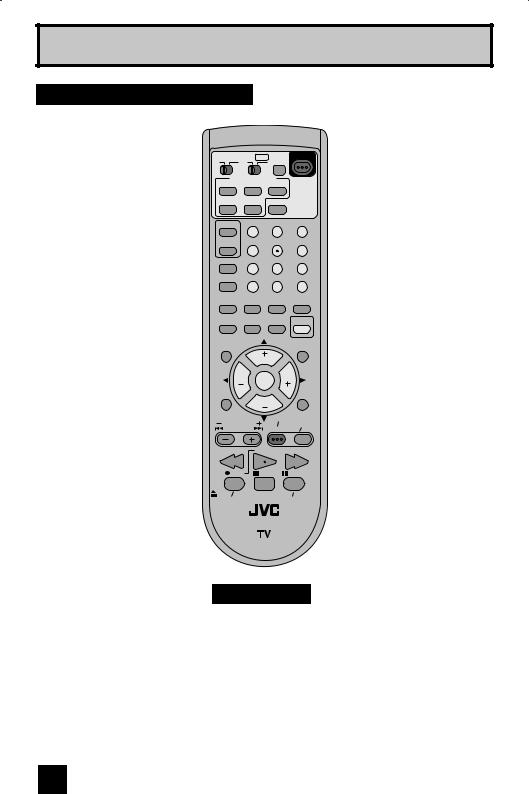
Quick Setup
Remote Control
TV CATV |
VCR DVD |
ASPECT |
POWER |
|
|
|
|
MULTI SCREEN |
|
||
SPLIT |
INDEX |
SELECT |
|
FREEZE |
SWAP |
DISPLAY |
|
INPUT |
1 |
2 |
3 |
D/A |
4 |
5 |
6 |
ML/MTS |
7 |
8 |
9 |
SLEEP |
TUNE |
0 RETURN+/TV |
|
FAVORITE |
THEATER |
VIDEO |
SUB |
PRO |
STATUS |
CHANNEL |
|
NATURAL
C.C.SOUND CINEMA LIGHT
MUTING |
|
|
GUIDE |
|
CH |
|
|
VOL |
OK |
VOL |
|
|
|
|
|
MENU |
|
|
BACK |
|
CH |
|
|
VCR CHANNEL |
VCR DVD |
||
PREV NEXT |
POWER |
TV VCR |
|
REW |
PLAY |
|
FF |
REC |
STOP |
|
PAUSE |
OPEN CLOSE |
|
STILL PAUSE |
|
RM-C18G |
|
|
|
RM-C18G
Notes:
•For information on remote control buttons, see pages 62 - 73.
•SUB CHANNEL and GUIDE buttons are for digital channels. If your TV is connected to an ATSC antenna or Digital Cable, you can use these buttons.
10
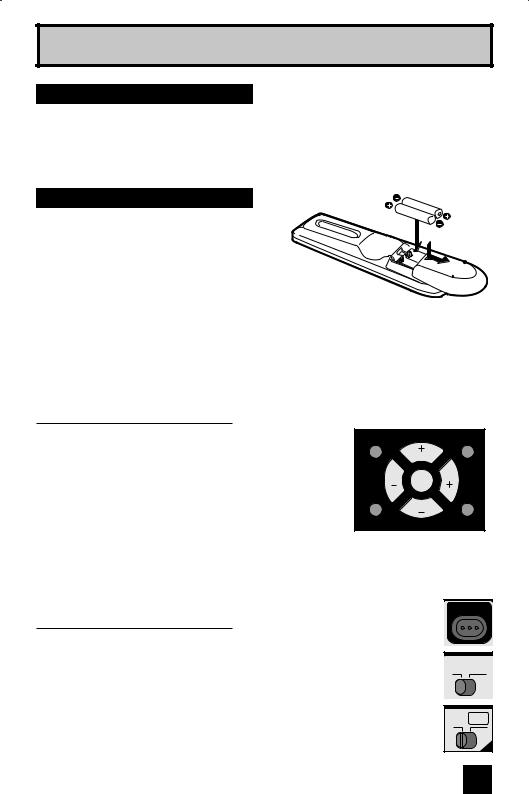
Quick Setup
Getting Started
These quick setup pages will provide you, in three easy steps, with the basic information you need to begin using your new television right away. If you have questions, or for more detailed information on any of these steps, please consult other sections of this manual.
Step 1 – The Remote Control
Before you can operate your remote control, you first need to install the batteries (included).
Slide the cover on the back of the remote down towards the bottom of the remote control. Insert
two batteries (included) carefully noting the “+” and “–” markings, placing the “–” end in the unit first. Slide the cover back into place.
When you change the batteries, try to complete the task within three minutes. If you take longer than three minutes, the remote control codes for your VCR, DVD, and/or cable box/satellite receiver may have to be reset. See pages 27 - 30.
Key Feature Buttons
The four key feature buttons at the center of the remote can be used for basic operation of the television. The top and bottom buttons will scan forward and back through the available channels. To move rapidly through the channels using
JVC’s Hyperscan feature, press and hold CH+ or CH–. The channels will zip by at a rate of five channels per second. The right and left buttons will turn the volume up or down. These buttons are also marked with four arrows and are used with JVC’s onscreen menu system. To use the onscreen menus, press the MENU button.
MUTING |
|
GUIDE |
|
CH |
|
VOL |
OK |
VOL |
|
|
|
MENU |
|
BACK |
CH
Basic Operation
Turn the television on and off by pressing the POWER button at the top right corner of the remote. If this is the first time you are turning on the TV, the interactive plug-in menu appears.
•Make sure the TV/CATV switch is set to TV. Move the switch to CATV only if you need to operate a cable box.
•Slide the VCR/DVD selector switch to VCR to control a VCR. Slide to
DVD to control a DVD player. Please see pages 27 to 30 for instructions on programming your remote control to operate a cable box, VCR or DVD player.
POWER
T
TV CATV
VCR DVD
11

Quick Setup
Step 2 - Connecting your devices
To make these connections, you will use plugs like the ones illustrated below.
Coaxial Cables |
Component Cables |
|
Composite Cables |
|
Audio Cables |
Used to connect an external antenna or cable TV system to your TV.
S-Video Cable
Used to make video connections with S-Video VCRs, Camcorders and DVD players.
Notes:
Used to connect audio/video devices like VCRs, DVD players, stereo amplifiers, game consoles, etc.
•These connections are examples.
•After you are finished connecting your devices, plug the power cord into the nearest power outlet and turn on the TV.
•If you follow these diagrams and the television does not work properly, contact your local cable operator.
•To connect a DVD player, see VCR Connection. A DVD player is optional
•If you have a satellite television system, refer to the satellite TV manual.
12
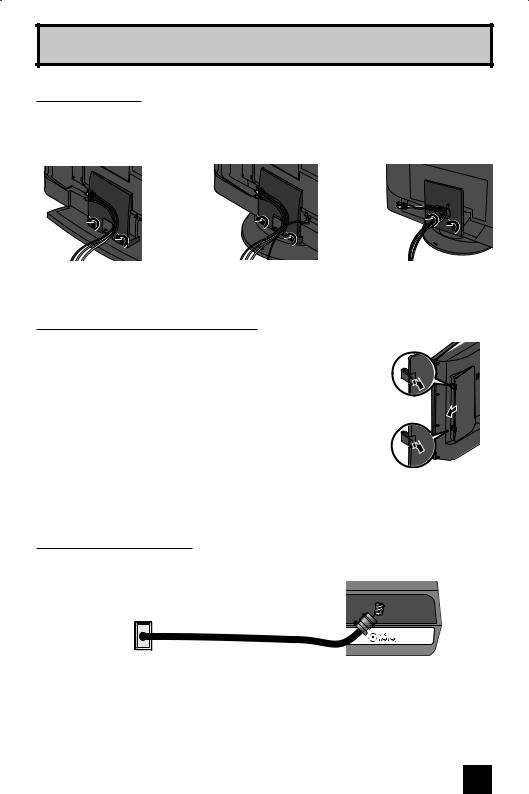
Quick Setup
Cable Holder
A cable holder which keeps your connection cables tidy is attached on the back of the stand.
To open, loosen the screws with you fingers. After putting the cables in the cable holder, attach it to the back of the stand again by tightening the screws with your fingers.
LT-40X887, LT-40X787 |
LT-37X887, LT-37X787 |
LT-32X887, LT-32X787, |
LT-40X667 |
LT-37XM57 |
LT-32X667 |
Remove the terminal cover
There are connection terminals behind the cover on the left in the back of the TV. Remove the cover before connecting an antenna or other devices. The cover can be removed by removing the hooks. When replacing the cover, place the side of the cover against the TV and insert the hooks.
Note:
• Leave the terminal cover off if they do not fit properly. Do not force to replace the cover. Doing so may damage the connection cables and cover.
No VCR Connection
TV Rear Panel
Cable or Antenna
Output Coaxial Cable (Attachment)
13
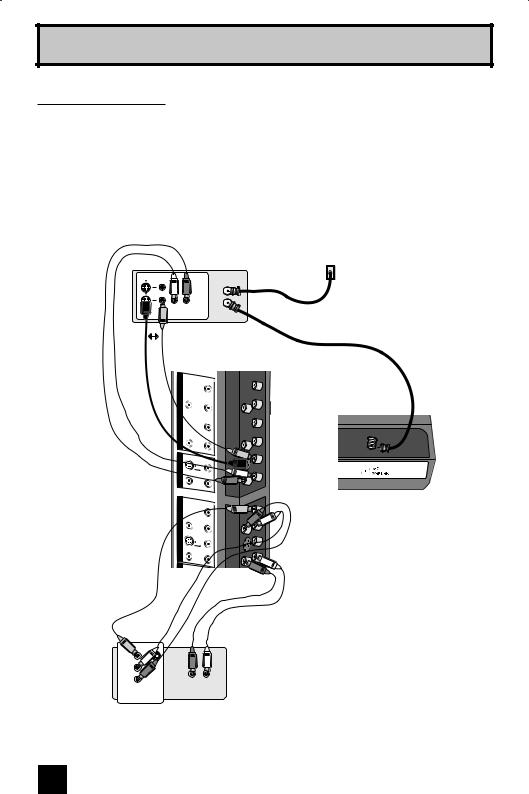
Quick Setup
VCR Connection
Notes:
•Green, blue and red are the most common colors for DVD cables. Some models may vary colors. Please consult the user’s manual for your DVD player for more information.
•Be careful not to confuse the red DVD cable with the red audio cable. It is best to complete one set of connections (DVD or audio output) before starting the other to avoid accidentally switching the cables.
•You may also connect the DVD player to Input 1.
Diagram #1
Cable or Antenna
Output
VCR
IN
IN
OUT
V L R
OUT
OR
Coaxial Cable (Attachment)
Y
Pr
Pb
3INPUT VIDEO
R |
- |
AUDIO |
- |
|
|
|
L |
INPUT 2
S-VIDEO |
|
|
||
|
|
|
VIDEO |
|
R |
OVER |
|
|
|
- |
AUDIO |
- |
|
|
|
|
L |
||
TV Rear Panel
Y
Pr Pb
1INPUT S-VIDEO VIDEO
R
OVER |
|
|
|
- |
AUDIO |
- |
|
|
L |
||
DIO
R |
INPUT |
Green |
Y |
|
|
|
Blue |
PB |
|
|
|
Red |
PR |
|
AUDIO OUT |
|
|
|
OUT |
R L |
DVD Player (OPTIONAL) |
|
|
|
Note:
• If this connection setup does not work for you, try the connection setup on page 15.
14
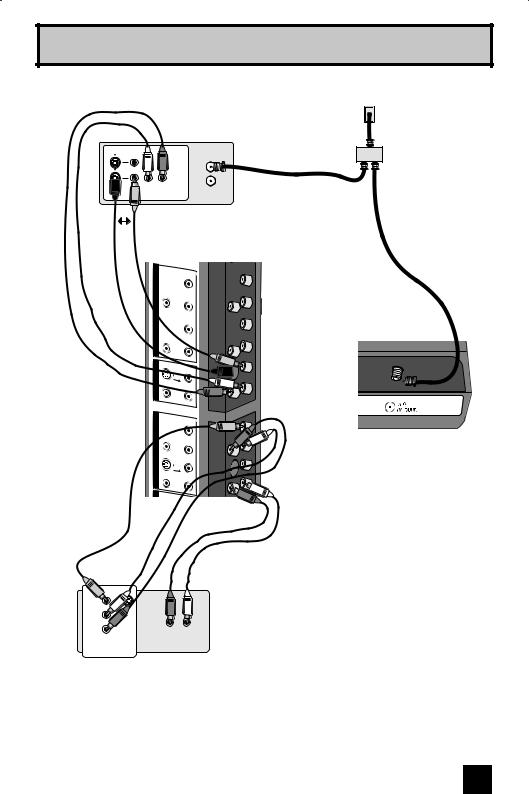
Quick Setup
Diagram #2
VCR
IN
IN
OUT
V L R
OUT
OR
Y
Pr
Pb
3INPUT VIDEO
R |
- |
AUDIO |
- |
|
|
|
L |
||
S-VIDEO |
|
|
||
|
|
|
VIDEO |
|
INPUT 2 |
OVER |
|
|
|
R |
- |
AUDIO |
- |
|
|
|
L |
||
|
|
|
||
|
|
|
|
Y |
Pr |
|
|
|
|
INPUT 1 |
|
|
|
Pb |
|
|
|
|
|
S-VIDEO |
|
|
||
|
|
|
VIDEO |
|
R |
OVER |
|
|
|
- |
AUDIO |
- |
|
|
|
|
|
L |
|
IO |
|
I |
|
|
Cable or Antenna
Output
IN
OUT OUT Two-Way Splitter
Coaxial Cable
(Attachment)
TV Rear Panel
Green |
Y |
|
|
Blue |
PB |
|
|
Red |
PR |
AUDIO OUT |
|
|
|
|
|
|
OUT |
R L |
DVD Player (OPTIONAL) |
15
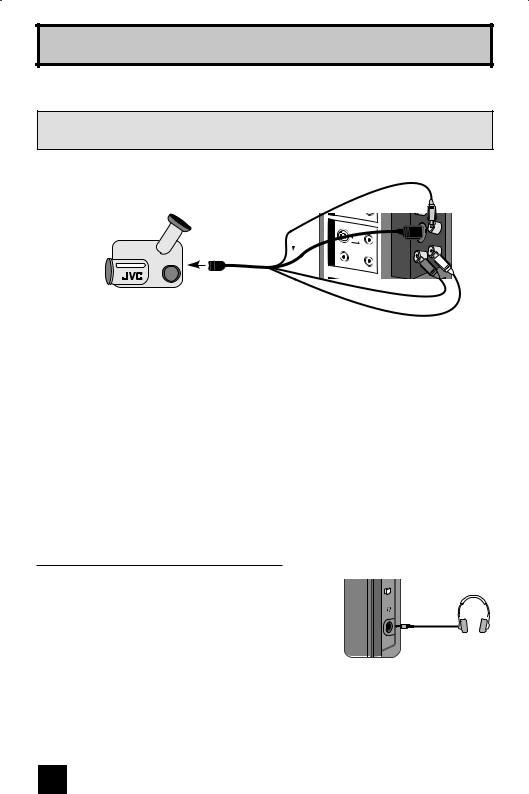
Quick Setup
Connecting to a Camcorder
You can connect a camcorder to you televison by using the input jacks located on the back of the television.
TV Rear Panel
CAMCORDER
 OR
OR
INPUT 2
S- |
|
|
|
|
VIDEO |
|
|
||
|
|
|
VIDEO |
|
R |
OVER |
|
|
|
- |
AUDIO |
- |
|
|
|
|
L |
||
1)Connect a yellow composite cable from the camcorder VIDEO OUT, into the VIDEO IN on the back of the TV, OR connect an S-Video cable from the camcorder to the back of the TV.
2)Connect a white cable from the camcorder LEFT AUDIO OUT, into the LEFT AUDIO IN on the back of the TV.
3)Connect a red cable from the camcorder RIGHT AUDIO OUT, into the RIGHT AUDIO IN on the back of the TV.
Note:
•If your camcorder is a mono sound model it will have only one AUDIO OUT. Connect it to the
LEFT AUDIO IN on the back of the TV.
Headphone Connection
You can connect a pair of headphones to the television using the headphone jack located on the side of the television.
1)Plug a headphone jack into the headphone jack on the television’s side panel.
POWER
TV Side Panel
16
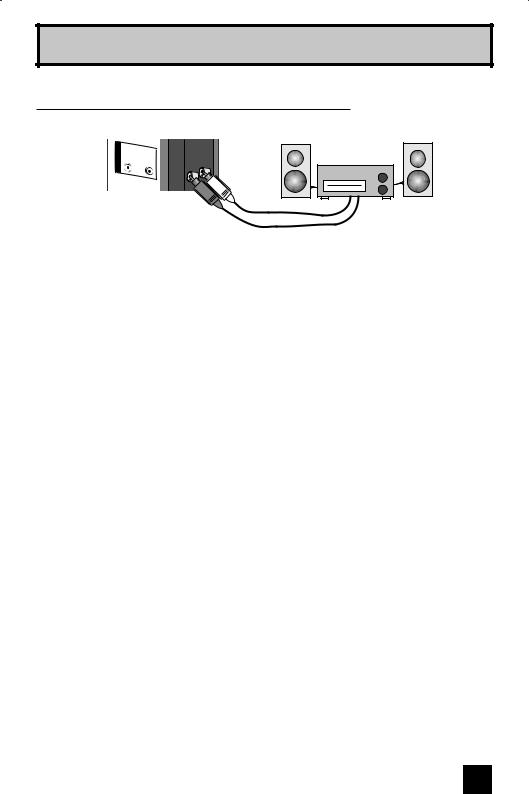
Quick Setup
Connecting to an External Amplifier
TV Rear Panel |
Speaker |
Speaker |
|
AUDIO OUT
R |
- |
AUDIO |
- |
|
|
|
L |
||
|
|
|
Amplifier
1)Connect a white cable from the LEFT AUDIO OUTPUT on the back of the TV to the LEFT AUDIO INPUT on the amplifier.
2)Connect a red cable from the RIGHT AUDIO OUTPUT on the back of the TV to the RIGHT AUDIO INPUT on the amplifier.
Notes:
•Refer to your amplifier’s manual for more information.
•You can use AUDIO OUTPUT for your home theater system.
•You can not output audio using the AUDIO OUTPUT under the following conditions:
1)When you have digital sound from an HDMI device connected to the HDMI 1 or HDMI 2 connection on the back of your TV. (See page 20).
2)When you have analog sound from a DVI device connected to the AUDIO IN "FOR
HDMI 1" connection. (See page 19).
17
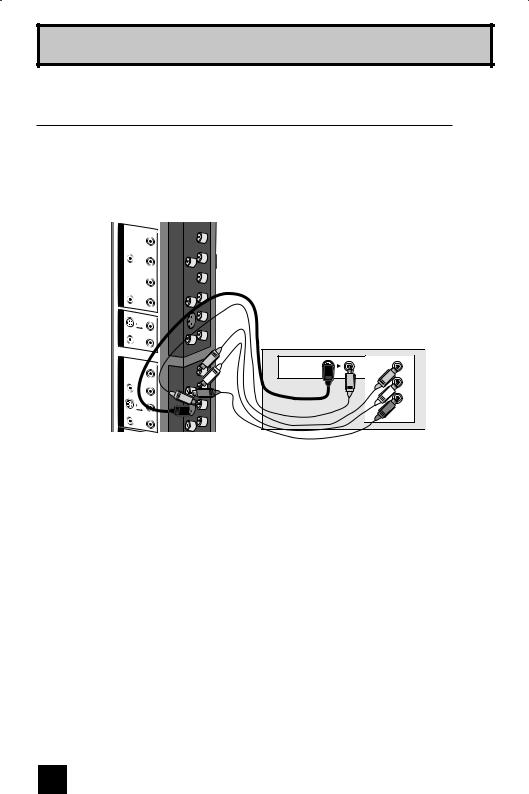
Quick Setup
Connecting to an AV Receiver using your television's V1 Smart Input
By connecting your AV Receiver to your television's V1 Smart Input, you can watch picture sources from many different devices, without having to change or use the other input connections on your TV. This allows you to free up the other input connections so you can connect more devices to your television.
TV Rear Panel
Y
Pr
Pb
3INPUT VIDEO
R |
- |
AUDIO |
- |
|
|
|
L |
||
S-VIDEO |
|
|
||
|
|
|
VIDEO |
|
INPUT 2 |
OVER |
|
|
|
R |
- |
AUDIO |
- |
|
|
|
L |
||
|
|
|
|
Y |
Pr |
|
|
|
|
INPUT 1 |
|
|
|
Pb |
|
|
|
|
|
S-VIDEO |
|
|
||
|
|
|
VIDEO |
|
R |
OVER |
|
|
|
- |
AU |
|
|
|
|
|
DIO |
- |
L |
IO |
|
I |
|
|
AV Receiver
MONITOR |
Y |
|
OUT |
||
|
||
|
PB |
|
|
PR |
|
|
MONITOR OUT |
1)Connect an S-Video Cable from the AV Receiver's MONITOR OUT, to the S-Video INPUT-1 on the back of your television.
2)Connect a Yellow Composite Cable from the AV Receiver's MONITOR OUT, into the VIDEO INPUT-1 on the back of your television.
3)Connect a Green Component Cable from the AV Receiver's Y MONITOR OUT, into the Y
VIDEO INPUT-1 on the back of your television.
4)Connect a Blue Component Cable from the AV Receiver's PB MONITOR OUT, into the Pb VIDEO INPUT-1 on the back of your television.
5)Connect a Red Component Cable from the AV Receiver's PR MONITOR OUT, into the Pr
VIDEO INPUT-1 on the back of your television.
Notes:
•This function does not apply to TV Model LT-32X667.
•Please refer to your AV Receiver instruction manual for more information on connecting your speakers and other devices like a DVD player.
•Use your AV Receiver's remote to switch to the different devices you have connected.
•Some AV Receivers may not respond when the V1 Smart Input function is turned on.
•If you have video connections for each input device connected to your AV Receiver, you should not connect them using both S-Video and Composite connection at the same time when you are using V1 Input as the V1 Smart Input. In this case we recommend using the S-Video connection.
18

Quick Setup
Connecting to a Digital TV Receiver
By connecting a Digital TV Receiver, high definition pictures can be displayed on your TV in their digital form.
DTV Decoder
DIGITAL OUT |
AUDIO OUT |
TV Rear Panel |
|
TV Rear Panel |
L |
R |
1 |
|
|
|
HDMI |
R |
A |
UDIO INPUT |
|
|||
|
|
L |
|
FOR |
|
|
|
OUT |
S-VIDEO |
||
|
|
VIDEO |
|
REC |
|
|
|
HDMI to DVI Cable
After the connections have been made, tighten the screw to secure the cables.
1)Connect the HDMI to DVI Cable from the DIGITAL OUT on the back of your DTV decoder, to the DIGITAL-IN on the back of your television.
2)Connect a red cable from the DTV decoder RIGHT AUDIO OUT, to the RIGHT AUDIO INPUT
"FOR HDMI 1" on the back of your television.
3)Connect a white cable from the DTV decoder LEFT AUDIO OUT, to the LEFT AUDIO INPUT "FOR HDMI 1" on the back of your television.
•The digital-in terminal is not compatible with the picture signal of a personal computer.
•Use a HDMI to DVI cable (commercially available) in order to digitally connect the television with a DTV decoder.
Notes:
•If 480p signals (640x480 or 720x480) are displayed on the screen, the horizontal balance may be slightly shifted. Access the “DIGITAL-IN” in the initial setup menu to adjust it. (Refer to page 52.)
•When you do the above connection, set DIGITAL-IN1 AUDIO in the Initial Setup menu to ANALOG. See "DIGITAL-IN1 AUDIO", page 52.
•The Analog Audio input can only be used with the HDMI 1 input.
•When setting the “DIGITAL AUDIO – ANALOG / DIGITAL” menu setting on the TV, please note that this setting only effects the HDMI 1 jack and that if you use a DVI to HDMI adapter this connection must be made to the HDMI 1 along with analog audio cables.
19

Quick Setup
Connecting to a HDMI Compatible Device
By connecting a HDMI compatible device, high definition pictures can be displayed on your
TV in their digital form. Some HDMI devices can include DVD players, D-VHS or any HDMI compatible device.
HDMI (High Definition Multimedia Interface) is the first industry supported, uncompressed, all digital audio/video interface. HDMI provides and interface between any audio/video source, such as a set-top box, DVD player, A/V receiver or an audio and/or video monitor, such as a digital television (DTV).
TV Rear Panel |
HDMI Compatible Device |
|
|
|
DIGITAL OUT |
AUDIO OUT |
|
|
|
L |
R |
HDMI Cable
1)Connect the HDMI Cable from the DIGITAL OUT on the back of your DTV or HDMI device, to the DIGITAL-IN on the back of your television.
Notes:
•When you do the above connection, set DIGITAL-IN1 AUDIO in the Initial Setup menu to
DIGITAL. See "DIGITAL-IN1 AUDIO", page 52.
•Some decoders may not respond depending on the equipment that you have connected when it is connected to the HDMI.
•If the HDMI output device signal is changed (for example, 480i/60Hz is changed to
480p/60Hz), the screen may turn green and there may be some distortion for a short time until the signal becomes stable.
•When you have an HDMI device connected to the HDMI 1 connection on the back of your TV, your TV detects it, and blocks the analog audio signal coming into the "FOR HDMI 1" jacks. Therefore, you can not hear any analog sound from the other device conected to the "FOR HDMI 1" jacks, while you are viewing the images from the HDMI device.
20

Quick Setup
Connecting to an amplifier using your optical output
You can connect an amplifier that has an optical digital input terminal by using an optical digital cable from the optical output. The signal that is output can be PCM or Dolby Digital.
Television Rear Panel
Amplifier
1) Connect the optical cable from underneath the television to the back of the amplifier.
Notes:
•This terminal can only output digital audio.
•In order to use the optical output connection, select PCM or Dolby Digital on Digital Sound in the Digital Setup Menu. See page 54.
•Refer to your owners manual on using your amplifier.
21
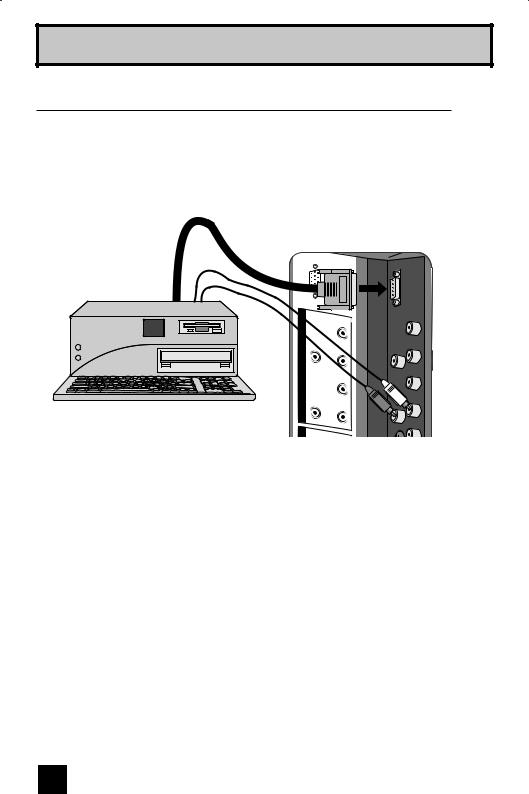
Quick Setup
Connecting to the computer
This TV can be used as a computer screen. Use a commercially available D-SUB cable to connect the TV's PC INPUT terminal to the computer's analog RGB output terminal. If you want to listen to the sound from the computer, use a commercially available RCA cable to connect the INPUT-3 audio input terminal to the computer's audio output terminal.
TV Rear Panel
PC IN (D-SUB)
Y
Pr
Pb
3INPUT VIDEO
R |
- |
AUDIO |
- |
|
|
|
L |
||
|
|
|
||
S-VIDEO |
|
|
||
Notes:
•Refer to your computer manual for a detailed explanation of the connections concerning your computer.
•Make sure that the connectors are facing the correct way when connecting.
•After connecting, tighten the two screws to fix the connectors in place.
Looking at the images from a computer
After starting the computer, press the INPUT button to choose INPUT-3. You can listen to the sound when the sound from the computer is connected to the INPUT-3 AUDIO input terminal.
Notes:
•When the sound from the computer is connected to INPUT-3 by choosing external input INPUT-3, the sound from the computer can be listened to, but the images from the computer cannot be seen.
22

Quick Setup
Table of signals for each type of computer
Resolution |
Vertical |
Horizontal |
|
Frequency |
Frequency |
|
(Hz) |
(kHz) |
|
|
|
640 x 480 |
60.0 |
31.5 |
(VGA) |
|
|
|
|
|
1024 x 768 |
60.0 |
48.4 |
(XGA) |
|
|
|
|
|
•Only the above formats are supported.
•Even with the above formats at 60 Hz, some problems may be experienced depending on the quality of the synchronous signal. (Depending on the quality, some pictures may not be displayed correctly).
•Apple Macintosh* computers are not supported.
When a picture is not displayed
With some computers, some problems can be solved by changing the settings. Check the computer's refresh rate and set it to 60Hz. Computers that cannot set the refresh rate to 60
Hz, can not be used with this TV. Refer to the computer's instruction manual.
*Apple Macintosh is a registered trademark of Apple Computer, Inc.
Note:
•If you are inputting a PC signal that is invalid, "Invalid Signal" will appear on the TV screen.
It appears when the input is PC and it is a single screen.
23

Quick Setup
Step 3 – The Interactive Plug In Menu
When you turn your television on for the first time the interactive plug-in menu will appear. The plug-in menu helps you to get your TV ready to use by letting you set your preferences for:
•The language in which you want the onscreen menus to appear.
•Setting the TV’s clock to the correct time so your timer functions will work properly. You can choose “AUTO” or “MANUAL” for setting the clock.
•The auto tuner setup of which channels you wish to receive.
We recommend you complete the interactive plug-in items before you start using your television.
Notes:
•The interactive plug-in menu setting does not appear if your TV has been turned on before.
In this case use the onscreen menus to perform these settings. See pages 44, 60 and 34.
•If you press the Menu button while setting up the interactive plug-in menu, it will skip over it.
Language
After the “JVC INTERACTIVE PLUG IN MENU” has been displayed, the TV automatically switches to the LANGUAGE settings. You can choose to view your onscreen menus in three languages: English, French (Français) or Spanish (Español).
LANGUAGE/LANGUE/IDIOMA |
|
|
|
|
|
|
|
|
ENGLISH |
|
|
|
NEXT |
|
|
|
|
|
|
|
SELECT OPERATE |
MENU EXIT |
|
|
|
|
|
è To choose a language:
(English, Français or Español)
†To NEXT (To set clock)
(To be continued...)
24
